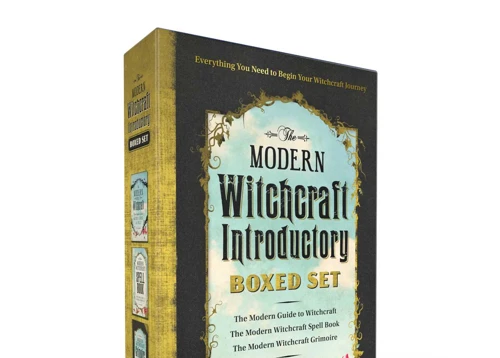Tarot cards have long fascinated and intrigued people with their mystical allure, but their influence reaches far beyond mere fortune-telling. In the realm of modern witchcraft, tarot has become an essential tool for divination, spellwork, personal development, and spiritual exploration. The intricate symbols and deep meanings found within the cards provide a powerful medium for witches to tap into their intuitive abilities and connect with the unseen energies of the universe. From choosing the right deck to conducting sacred rituals, this article will delve into the various ways in which tarot enhances and enriches witchcraft practices, allowing witches to unlock their inner power and navigate their spiritual journeys with wisdom and clarity.
Contents
- Understanding Tarot
- Tarot in Modern Witchcraft
- Choosing and Connecting with Tarot Decks
- Magic and Rituals with Tarot
- Enhancing Witchcraft Practices with Tarot
- Exploring Tarot Archetypes in Witchcraft
- Empowering the Witch through Tarot
- Conclusion
-
Frequently Asked Questions
- How can tarot be used for divination?
- What is the significance of tarot symbolism?
- How does tarot enhance personal development?
- Are there different types of tarot decks?
- What role does intuition play in tarot reading?
- Can tarot cards be used for spellwork?
- How can tarot be used for shadow work?
- What are some popular tarot spreads?
- Is it necessary to have psychic abilities to read tarot?
- How can tarot be incorporated into daily spiritual practice?
- References
Understanding Tarot
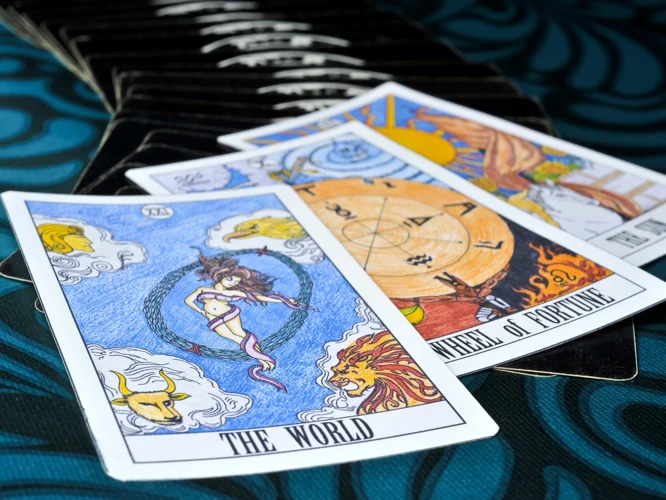
Tarot, a deck of 78 cards with intricate symbolism, holds a captivating history that spans centuries. Its origins can be traced back to the 15th century in Europe, but the true essence of tarot lies in its ability to tap into the collective unconscious and provide guidance and insights. Each card holds a unique meaning and symbolism, representing various archetypes and life experiences. The images depicted on the cards range from fantastical creatures to everyday scenes, showcasing a rich tapestry of human existence. Tarot has not only served as a tool for divination but has also influenced various aspects of culture, from art and design to fairy tales and folklore. Its resurgence in the 19th century during the occult revival further cemented its place in mystical practices, attracting seekers from all walks of life. Understanding the intricacies of tarot allows practitioners to unlock its immense potential and tap into the wisdom and guidance it offers. To explore more about the influence of tarot on fairy tales and folklore, you can refer to this article. If you are interested in the role of tarot during the occult revival of the 19th century, you can find more information in this article. Additionally, the art and design of tarot cards have inspired countless artists throughout the years, leaving a lasting impact on the world of visual aesthetics.
Origin and History
The origin and history of tarot cards can be traced back to the 15th century, primarily in Europe. While the exact origins of tarot are shrouded in mystery, it is widely believed that the cards were initially used for card games. The earliest surviving tarot decks were hand-painted and commissioned by wealthy families, showcasing intricate designs and symbolic imagery. These decks, known as the Visconti-Sforza Tarot decks, featured beautiful illustrations that reflected the social and cultural norms of the time. Over the centuries, tarot cards evolved from being solely used for gaming into a tool for divination and spiritual exploration. The most famous tarot deck, the Rider-Waite Tarot deck, was created in the early 20th century by occultist Arthur Edward Waite and artist Pamela Colman Smith. This deck introduced innovative symbolism and became the foundation for many modern tarot decks. Today, tarot cards are widely used by practitioners of various spiritual traditions, including witchcraft, as a means of connecting with divine wisdom and gaining insights into the past, present, and future. The art and design of tarot cards continue to inspire artists, with various interpretations and creative adaptations emerging. To explore more about the art and design of tarot cards, you can refer to this informative article.
Meaning and Symbolism
In tarot, each card holds a profound and nuanced meaning, making it a powerful tool for self-reflection and guidance. The symbolism embedded within the tarot deck is a language of archetypes, elements, and universal experiences. Here is a breakdown of the meanings and symbolism commonly associated with tarot cards:
1. Major Arcana: The Major Arcana consists of 22 cards that represent significant life events and spiritual lessons. Each card is rich in symbolism, portraying themes such as personal transformation, enlightenment, and spiritual evolution. For example, The Fool card signifies new beginnings and taking leaps of faith, while The Empress represents nurturing and abundance.
2. Minor Arcana: The Minor Arcana consists of four suits—Wands, Cups, Swords, and Pentacles—each associated with different aspects of life. The Wands reflect personal passions and creativity, Cups represent emotions and relationships, Swords symbolize intellect and challenges, and Pentacles signify material aspects and abundance. Each suit further contains cards numbered from Ace to Ten, along with court cards such as Pages, Knights, Queens, and Kings, adding depth to the interpretations.
3. Colors and Elements: Colors play a significant role in tarot symbolism. The vibrant hues and shades used in the cards evoke various emotions and energies. For example, the color red often represents passion and energy, while blue symbolizes intuition and spirituality. Additionally, the elements—Fire, Water, Air, and Earth—associated with each suit contribute to the overall meaning of the cards. Fire represents passion and transformation, Water signifies emotions and intuition, Air symbolizes intellect and communication, and Earth embodies practicality and grounding.
4. Numerology: Numerology plays a crucial role in tarot interpretation. Each number on the cards holds its own symbolism and significance. For instance, the number One represents new beginnings and individuality, while the number Ten signifies completion and fulfillment. Understanding the numerical associations adds layers of meaning to the cards.
It’s important to note that while tarot cards hold universal symbolism, individual interpretation and intuition also play a significant role in understanding their meaning in specific readings. The rich tapestry of symbols and archetypes in tarot provides a comprehensive framework for delving into the depths of the subconscious and uncovering hidden truths.
Tarot in Modern Witchcraft
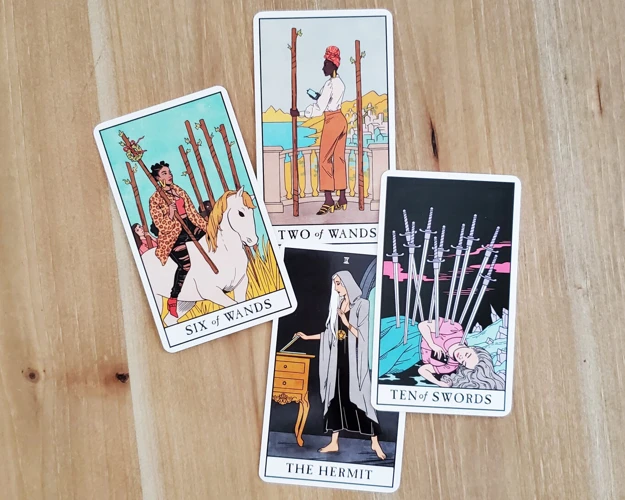
Tarot has become an integral part of modern witchcraft practices, serving as a versatile tool that goes beyond the realm of fortune-telling. In the world of witchcraft, tarot cards are used for divination and spellwork, allowing practitioners to gain insights, guidance, and clarity. Through the process of laying out the cards and interpreting their meanings, witches can connect with their intuition and tap into the forces of the unseen. Tarot serves as a powerful medium for personal development and spiritual growth, enabling witches to delve into their subconscious, confront their fears, and embrace their strengths. Whether it’s seeking answers, setting intentions, or manifesting desires, tarot provides a sacred channel for witches to harness their own power and co-create their reality. It is through the integration of tarot into modern witchcraft practices that witches are able to deepen their connection with the spiritual realm and cultivate a profound understanding of themselves and the universe.
Divination and Spellwork
Divination and spellwork form the backbone of tarot’s usage in modern witchcraft, encompassing a wide range of practices that tap into the mystical and metaphysical aspects of the cards. Let’s explore how tarot is employed in both divination and spellwork:
– Divination: Tarot cards are commonly used for divination, the practice of gaining insight into the past, present, or future. By shuffling and drawing cards, practitioners can interpret the symbols, images, and meanings to gain intuitive guidance. Each card’s placement within a spread, such as the Celtic Cross or Three-Card Spread, adds depth and context to the reading. The cards act as a conduit for divine messages, allowing witches to tap into psychic energies and receive guidance on various aspects of life, including love, career, and personal growth.
– Spellwork: Tarot cards are not only used for gaining insight but also in spellcasting. Specific cards are chosen based on their symbolism and intention to enhance the desired outcome of a spell. For example, the High Priestess card may be used in a spell focused on intuition and spiritual development, while the Wheel of Fortune card may be incorporated into a spell aimed at inviting positive changes and opportunities. The cards can serve as powerful visual aids, representing the energies and intentions the witch desires to manifest. The placement and arrangement of the cards during spellwork can also add layers of meaning and intention.
In both divination and spellwork, it is important for practitioners to develop a deep connection with the cards, allowing their intuition to guide the interpretations. The imagery, symbols, and archetypes within the tarot deck act as gateways to the subconscious and spiritual realms, providing a platform for witches to tap into their innate powers and manifest their desires. The combination of divination and spellwork with tarot empowers witches to navigate life’s challenges, gain insight, and create meaningful change in their lives.
Personal Development and Spirituality
Embracing tarot as a tool for personal development and spiritual growth is a common practice among modern witches. The intuitive nature of tarot cards allows individuals to connect with their higher selves, gain self-awareness, and embark on a journey of self-discovery. Through tarot readings, witches can gain insights into their strengths, weaknesses, and deepest desires. The cards serve as mirrors, reflecting the hidden aspects of one’s psyche and shedding light on areas of growth and transformation. Tarot offers a framework for self-reflection and introspection, encouraging individuals to confront their fears and limitations, and explore their innermost dreams and aspirations. It helps witches cultivate mindfulness, as they learn to be present in the moment and tune into their intuition. The archetypes represented in the tarot deck provide a language through which witches can explore the universal human experience and understand the interconnectedness of all beings. Tarot readings can also act as catalysts for spiritual awakening, stirring a profound sense of connection to something greater than oneself. Whether it’s seeking guidance on a specific issue or embarking on a journey of self-discovery, tarot offers a transformative path for personal growth and spiritual development.
Choosing and Connecting with Tarot Decks
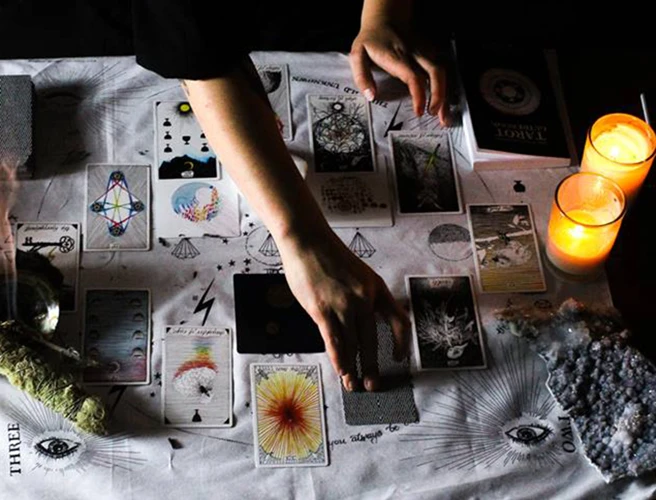
When it comes to choosing a tarot deck, intuition and energy play a vital role. The connection between a witch and their deck is deeply personal and unique. Trusting your intuition is key to selecting a deck that resonates with your energy and spiritual practice. There are numerous types of tarot decks to choose from, each with its own artistic style, symbolism, and theme. Traditional Rider-Waite-Smith decks are a popular choice, known for their iconic imagery and widespread use. However, there are also modern decks that offer fresh perspectives and unique interpretations. Exploring different decks and their visual aesthetics can help you find one that sparks a connection within you. Once you have chosen your deck, it’s essential to establish a strong bond with it. Cleansing and consecrating the deck can help clear any residual energies and infuse it with your own intentions. Regularly handling and shuffling the cards will deepen your connection and attune your energy to the deck. Remember, your tarot deck is not merely a tool, but a conduit for your intuition and inner guidance. Trust your instincts and embrace the magical journey that awaits when you connect with your chosen tarot deck.
Intuition and Energy
Intuition plays a vital role in tarot and its connection to energy. When working with tarot cards, individuals rely on their intuition to interpret the messages and guidance they receive. Tarot readings are not solely based on logical reasoning or external information but are enhanced by tapping into one’s innate intuitive abilities. Intuition allows practitioners to feel the energetic vibrations of the cards and receive deeper insights that go beyond the surface level meanings. It is through intuition that practitioners can sense the subtle nuances and hidden symbolism within each card, uncovering layers of information that may be missed by a purely rational approach. Trusting one’s intuition is key in developing a more profound connection with the tarot and harnessing its power for personal growth and spiritual exploration. Additionally, the concept of energy is closely intertwined with intuition in tarot practice. Each card carries its unique energetic signature, which is influenced by the archetype it represents. Understanding and attuning to the energy of the cards allows practitioners to tap into the collective consciousness and tap into universal wisdom. Working with the energy of the cards can amplify the intuitive messages received and provide a deeper understanding of the guidance they offer. It is important for practitioners to cultivate their own energetic awareness and sensitivity in order to fully harness the transformative power of tarot.
Types of Tarot Decks
When it comes to tarot decks, there is a vast array of options available, each with its own unique energy and symbolism. Here are some of the most popular types of tarot decks:
1. Rider-Waite-Smith (RWS) Tarot: Considered the gold standard of tarot decks, the RWS Tarot was created in the early 20th century. It features traditional imagery and symbolism, making it an ideal choice for beginners. The deck includes 78 cards, with 22 Major Arcana and 56 Minor Arcana cards.
2. Thoth Tarot: Designed by Aleister Crowley and Lady Frieda Harris, the Thoth Tarot deck is deeply rooted in occult symbolism and esoteric concepts. It showcases vibrant and detailed artwork, illustrating the profound connections between astrology, Kabbalah, and tarot. The Thoth Tarot consists of 78 cards and offers a more complex and intricate reading experience.
3. Marseille Tarot: Dating back to the 16th century, the Marseille Tarot is one of the oldest tarot decks in existence. It features simple yet powerful illustrations, emphasizing the elemental and foundational aspects of tarot. The Marseille Tarot consists of 78 cards, with bold colors and minimalistic imagery.
4. Fairy Tarot: As the name suggests, Fairy Tarot decks incorporate mythical creatures and enchanting imagery inspired by the world of fairies. These decks often provide a whimsical and lighthearted interpretation of tarot, perfect for those seeking a more playful approach to their readings.
5. Animal Tarot: Animal-themed tarot decks focus on the wisdom and energies of the animal kingdom. These decks use animals as symbols to convey deeper meanings and insights. Each animal represents different qualities and characteristics, offering guidance and connection to nature.
6. Oracle Decks: While not strictly tarot decks, oracle decks are often used alongside tarot cards for additional guidance and clarification. Oracle decks come in various themes, such as angels, goddesses, crystals, or nature, and provide intuitive messages and divination tools.
Remember, the choice of tarot deck ultimately depends on personal preference and resonance. Whether you’re drawn to traditional symbolism, mystical art, or whimsical themes, finding the right deck can enhance your tarot practice and unlock deeper insights. Embrace the deck that speaks to your soul and resonates with your intuition.
Magic and Rituals with Tarot
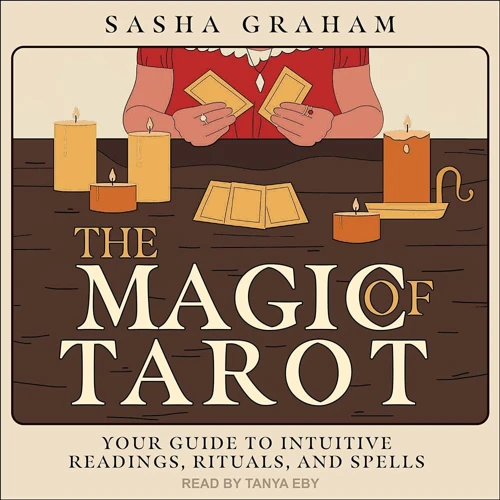
Magic and rituals intertwine seamlessly with the practice of tarot, offering practitioners a powerful means to manifest their desires and connect with the spiritual realm. Tarot spells and manifestations harness the energy and intention of specific cards to bring about change in one’s life. Whether it’s a love spell using The Lovers card or a prosperity spell utilizing The Empress card, the symbolism and energy of each tarot card can be utilized to create a focused and intentional magical working. In addition to spells, sacred tarot rituals provide a structured framework for deepening one’s connection with the divine and tapping into higher realms of consciousness. These rituals often involve cleansing and consecrating the tarot deck, calling upon deities or spirit guides, and performing divination or meditation with the cards. Incorporating tarot into magical practices allows for a deeper level of spiritual engagement and empowers practitioners to manifest their intentions with clarity and intentionality.
Tarot Spells and Manifestation
Tarot Spells and Manifestation: Tarot cards are not only tools for divination but also potent instruments for casting spells and manifesting desires. Through the use of tarot spells, practitioners can harness the symbolic imagery and energetic vibrations of the cards to bring about positive changes in their lives. Each card holds its unique energy and symbolism, which can be aligned with specific intentions to amplify the manifestation process. The process begins by selecting cards that resonate with the desired outcome or intention. These cards are then arranged in a particular spread or pattern, creating a visual representation of the spell’s intention and desired manifestation. The practitioner may choose to incorporate additional tools or rituals to enhance the spell, such as candles, crystals, or affirmations. By focusing their energy and intention on the chosen cards, practitioners tap into the collective unconscious and the divine guidance of the tarot to manifest their desires into reality. It is important to note that tarot spells are not about manipulating or controlling the outcome but rather aligning with the natural flow of energy and the will of the universe. They serve as powerful tools for self-reflection, intention setting, and co-creation. Through the exploration of tarot spells and manifestation, practitioners can deepen their connection with the cards and unlock the transformative potential within themselves.
Sacred Tarot Rituals
Sacred Tarot rituals are a powerful way to deepen your connection with the cards and tap into their mystical energy. These rituals can be performed during specific moon phases, Sabbats, or whenever you feel the need to infuse your practice with an extra dose of spirituality. There are various rituals you can explore to enhance your tarot practice:
1. Cleansing Ritual: Before conducting any sacred tarot ritual, it is important to cleanse your deck. You can do this by smudging the cards with sacred herbs, such as sage or palo santo, or by placing them under the light of the moon. Cleansing helps remove any stagnant energy and ensures your deck is ready for use.
2. Charging Ritual: Once your deck is cleansed, you can charge it with your personal intention. Hold the cards in your hands and visualize white light surrounding them. State your intention clearly, such as “I charge this deck with love and wisdom for my highest good.” This ritual aligns the energy of the cards with your own intentions and creates a sacred bond between you and the deck.
3. Ritual of Illumination: This ritual involves selecting a card that represents an area of your life you wish to gain insight into or receive guidance on. Take a few moments to meditate on the card, observing its imagery and symbolism. Allow the wisdom of the card to illuminate your path and provide clarity to your situation.
4. Full Moon Ritual: The full moon is a potent time for magical workings. During this ritual, place your deck under the moonlight and envision the moon’s energy infusing the cards with wisdom and guidance. Leave them overnight, allowing them to absorb the moon’s energy. The next day, you can use the deck for readings, spellwork, or personal reflection, knowing that it is charged with the lunar energy.
5. Elemental Ritual: Another sacred ritual involves connecting with the elements. Arrange four candles, each representing one of the elements: earth, air, fire, and water. Shuffle the deck while focusing on each element and its influence in your life. Pull a card for each element and reflect on its meaning and relevance. This ritual helps you tap into the elemental forces and their guidance.
Remember, these rituals are meant to be personal and intuitive. Feel free to modify them or create your own based on your spiritual beliefs and practices. By incorporating sacred tarot rituals into your witchcraft practice, you can deepen your connection with the cards and align yourself with the higher energies they represent.
Enhancing Witchcraft Practices with Tarot
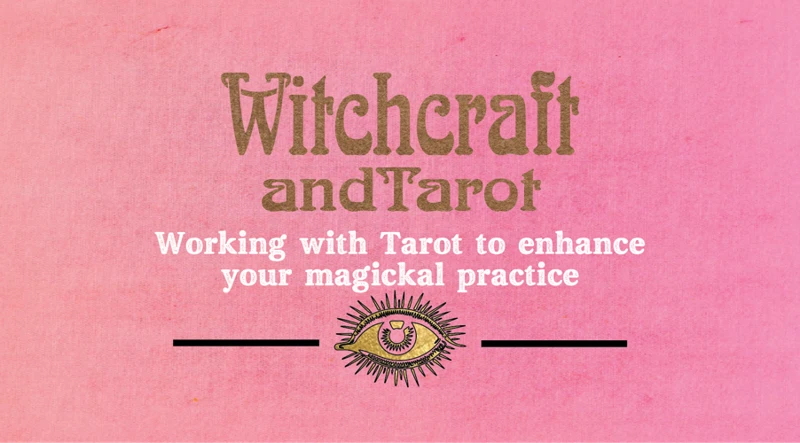
Tarot cards hold immense power for enhancing and deepening witchcraft practices. One way to harness this power is through card meditations and visualizations. By selecting a card and immersing oneself in its imagery, a witch can tap into the energy and symbolism of the card, allowing it to guide and inspire their magical workings. This practice enables a deep connection between the witch and the tarot, fostering intuition and amplifying the personal energy used in spellwork. Journaling is another avenue for utilizing the power of tarot in witchcraft. Through writing about the cards pulled or the readings performed, witches can gain valuable insights, track their progress, and gain a deeper understanding of their own magical journey. It is through these practices that tarot becomes not only a divinatory tool but also a transformative and empowering force for witches, allowing them to explore their inner realms, nurture their spirituality, and manifest their desires with intention and clarity.
Card Meditations and Visualizations
Card meditations and visualizations are powerful practices that allow witches to deepen their connection with tarot cards and access the wisdom and energy contained within them. During a card meditation, a witch selects a specific card from the deck and takes time to meditate on its imagery, symbolism, and meaning. The witch may choose to focus on a particular aspect of the card, such as a specific symbol or character, allowing it to come to life in their mind’s eye. Through this process, the witch enters a state of deep relaxation and receptivity, enabling them to receive intuitive insights and messages from the card. Visualizations, on the other hand, involve actively visualizing oneself as a character or embodying the energy of the card. This practice can be especially potent when working with cards that represent certain archetypes or energies that the witch wants to align with. For example, visualizing oneself as the Empress card may ignite feelings of nurturing and abundance, while visualizing as the Magician card may enhance personal power and manifestation abilities. By regularly engaging in card meditations and visualizations, witches develop a profound relationship with the tarot deck, allowing them to access its transformative energy and harness its guidance in their spiritual and magical endeavors.
Journaling and Tarot Work
Journaling is a powerful and transformative practice that can greatly enhance tarot work within the realm of witchcraft. By combining the act of writing with the intuitive guidance of tarot cards, practitioners can delve deeper into their thoughts, emotions, and spiritual journey. Journaling allows for a reflective space where one can explore the messages and insights received from tarot readings. It helps in processing and understanding the symbolism and meanings behind the cards, as well as providing a record of personal growth and progress.
When engaging in journaling and tarot work, it is important to create a sacred space, free from distractions, where you can fully immerse yourself in the practice. Begin by selecting a tarot card or a tarot spread that resonates with your current situation or question. Take a few moments to study the card(s) and observe any thoughts or feelings it evokes within you. Allow the energy of the card to guide your journaling process.
Start by writing down the card’s imagery, symbols, and any immediate impressions or intuitive insights that come to mind. Explore the card’s meaning and symbolism and how it relates to your current circumstances. Reflect on any personal experiences or emotions that the card brings to the surface. If using a tarot spread, record the position and interpretation of each card within the spread.
As you explore your tarot reading through journaling, let your thoughts and emotions flow freely onto the pages. This process allows for self-reflection, introspection, and deeper understanding. Consider writing about any patterns or recurring themes you notice within your readings. Notice how your interpretations may evolve over time as you gain more experience and wisdom.
Journaling your tarot work can also serve as a valuable reference for future readings. You can revisit your previous entries to gain insights into patterns, lessons, and growth. Over time, this journal becomes a personal grimoire, holding a wealth of wisdom and guidance unique to your individual spiritual journey.
Remember, there is no right or wrong way to journal with tarot. It is a personal practice that should be tailored to your own needs and preferences. Experiment with different writing prompts, styles, or formats that resonate with you. The key is to approach your journaling practice with open-mindedness and authenticity, allowing the fusion of tarot and journaling to deepen your connection with your inner self and the mystical energies that surround you.
Exploring Tarot Archetypes in Witchcraft
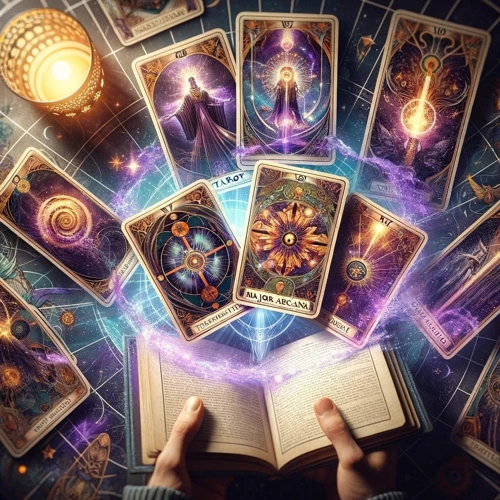
Exploring the tarot archetypes within the realm of witchcraft opens up a world of deep symbolism and spiritual connections. The Major Arcana, comprised of 22 cards, represents archetypal forces and significant life lessons. Each card embodies a powerful archetype, such as the Magician, High Priestess, or the Fool, which witches can draw upon to enhance their spellwork and spiritual practices. These archetypes serve as guides and mirrors, reflecting different aspects of the human experience and allowing witches to tap into universal energies. In addition to the Major Arcana, the Minor Arcana, consisting of four suits (Wands, Cups, Swords, and Pentacles), provides a rich tapestry of everyday situations and energies that can be harnessed for spellcraft. By understanding and working with these archetypes, witches can align themselves with the deeper meanings and energies represented by the cards, bringing intention, power, and depth to their witchcraft practices.
The Major Arcana and Witchcraft
The Major Arcana, consisting of 22 cards in a tarot deck, holds immense significance in the realm of witchcraft. Each card represents a powerful archetype and embodies a profound spiritual lesson or journey. These cards serve as a doorway to deep introspection and self-reflection for witches, allowing them to explore the various aspects of their own psyche and tap into their inner power. The Major Arcana cards are often used in rituals and spellwork to invoke the energy and symbolism associated with each card. For example, The High Priestess card embodies the divine feminine energy and can be utilized in rituals related to intuition, psychic abilities, and connecting with the spiritual realm. The Death card represents transformation and rebirth, making it a potent card for rituals centered around letting go of the old and embracing new beginnings. The Fool card symbolizes taking risks and stepping into the unknown, making it ideal for spells related to personal growth and embracing new opportunities. The Major Arcana cards serve as potent catalysts for witches to connect with the ancient archetypes and harness their power within their magical practices. Implementing these cards in rituals, spellcasting, and meditation allows witches to tap into the deep wisdom contained within the Major Arcana and manifest their intentions with clarity and purpose.
The Minor Arcana and Spellcraft
The Minor Arcana in tarot consists of four suits: Wands, Cups, Swords, and Pentacles. Each suit is associated with particular elements, energies, and aspects of life. When it comes to spellcraft, the Minor Arcana cards offer a wealth of symbolism and potential. The Wands represent passion, creativity, and inspiration, making them ideal for spells related to ambition, career success, or personal projects. The Cups embody emotions, love, and intuition, making them powerful tools for spells focused on relationships, healing, or enhancing psychic abilities. The Swords signify intellect, communication, and truth, making them effective for spells involving justice, clarity, or cutting ties with negativity. The Pentacles embody material abundance, stability, and manifestation, making them perfect for spells related to money, home, or grounding. To utilize the energy of the Minor Arcana cards in spellcraft, you can incorporate them into candle rituals, charm bags, or visualization exercises. By selecting a card that aligns with your intention and placing it on your altar or incorporating its imagery into your spellwork, you can tap into the specific energies of that suit and enhance the potency of your magic. Remember to trust your intuition and work with the cards that resonate with you personally, as this will enhance the effectiveness of your spellcraft and strengthen your connection to the tarot.
Empowering the Witch through Tarot
Tarot cards serve as a powerful tool for witches, empowering them to delve deep into their inner selves and enhance their magical abilities. Through tarot, witches can embark on a journey of self-reflection and shadow work, uncovering hidden aspects of themselves and integrating their shadows for personal growth. The cards act as a mirror, reflecting the subconscious mind and bringing unresolved issues to the surface, allowing witches to confront and heal them. Tarot enables witches to channel their intuition and hone their psychic abilities. By connecting with the cards on a deep energetic level, witches can tap into their innate intuitive powers and receive guidance from the spiritual realms. This connection enhances their spellwork, divination, and manifestation practices, enabling them to manifest their intentions with greater clarity and precision. Tarot truly empowers the witch, providing a pathway to self-discovery, empowerment, and the unleashing of their magical potential.
Self-Reflection and Shadow Work
Self-reflection and shadow work are two powerful aspects of personal growth and spiritual development that can be enhanced through the use of tarot. Self-reflection involves introspection and examining one’s thoughts, emotions, and experiences to gain deeper self-awareness. Tarot cards provide a mirror to the inner self, allowing individuals to explore their subconscious desires, fears, and hidden aspects of their personality. The tarot acts as a tool for self-discovery, shedding light on the parts of ourselves that we may have suppressed or ignored. Through the imagery and symbolism of the cards, we can confront our shadows and navigate the depths of our psyche. The concept of shadow work, popularized by psychologist Carl Jung, involves acknowledging and integrating the darker aspects of our being. Tarot can aid in this process by bringing these shadow aspects to consciousness and assisting in our journey of self-acceptance and healing. The cards can help us confront our fears, insecurities, and unresolved traumas, helping us release the energy attached to these experiences and facilitate personal transformation. By working with tarot in self-reflection and shadow work, individuals can gain a deeper understanding of themselves, develop self-compassion, and ultimately achieve inner harmony and growth. This process is best supported by journaling as a means of recording insights, emotions, and reflections sparked by tarot readings. Creating a regular practice of tarot journaling can establish a deeper connection to the cards and facilitate the integration of shadow aspects into daily life.
Channeling Intuition and Psychic Abilities
– Trusting your intuition is a key aspect of both tarot and witchcraft. Tarot cards serve as a bridge to accessing your intuition and deepening your psychic abilities. As you work with the cards, you strengthen your connection to your inner wisdom, allowing it to guide you in your spiritual journey.
– Tarot can help you tap into your psychic abilities by encouraging you to listen to the subtle messages and symbols that arise during a reading. The imagery and symbolism in the cards act as a catalyst to stimulate your intuition and unlock your psychic potential. Through regular practice, you can develop your intuition and psychic senses, enabling you to receive and interpret information from the spiritual realm more easily.
– One technique for channeling intuition and psychic abilities with tarot is to practice meditation with the cards. Take a quiet moment to sit with a specific card, studying its imagery and allowing your mind to relax and become receptive. This practice helps you attune to the energy of the card and open yourself to intuitive insights and messages.
– Another method is to engage in card exercises to enhance your psychic abilities. For example, you can shuffle the deck, draw a card, and focus on the energy it emits. Pay attention to any thoughts or feelings that arise as you gaze at the card. This exercise helps sharpen your intuition and deepen the connection with your psychic senses.
– Journaling about your tarot readings and intuitive experiences can also contribute to channeling intuition and psychic abilities. By recording your insights, thoughts, and emotions in a journal, you create a space for reflection and self-discovery. This practice allows you to identify patterns, track your progress, and gain a deeper understanding of your intuitive gifts.
– Ultimately, channeling intuition and psychic abilities through tarot is a personal and ongoing journey. Embrace the process, trust your inner guidance, and allow the cards to serve as a tool for unlocking and expanding your psychic potential. With practice and intention, you can develop a strong connection with your intuition and enhance your psychic abilities, empowering your witchcraft practices and spiritual growth.
Conclusion
In conclusion, tarot has cemented its place as a powerful tool in modern witchcraft practices. Its origins and rich symbolism make it a captivating medium for divination, personal growth, and spiritual exploration. Through tarot, witches can tap into their intuitive abilities, connect with the energy of the universe, and gain profound insights into their lives. The tarot deck acts as a mirror, reflecting the complexities of the human experience and offering guidance and wisdom with each card drawn. Whether used in spellwork, rituals, or self-reflection, tarot empowers witches to delve deep into their psyche, uncover hidden truths, and navigate their spiritual journeys with clarity and purpose.
Furthermore, the impact of tarot extends beyond individual practice. It has influenced various aspects of culture, from art and design to folklore and literature. The archetypal imagery found within the cards has inspired countless artists and writers throughout history, leaving a lasting imprint on the creative world.
Ultimately, tarot and its influence on modern witchcraft practices is a testament to the power of intuition, self-reflection, and connection to the unseen realms. By embracing the wisdom offered by the tarot, witches can enhance their craft, strengthen their spiritual connection, and unlock their inner power. It serves as a reminder that magic and spirituality are intrinsically intertwined, and through the use of tarot, witches can deepen their understanding of themselves and the world around them. So, whether you are a seasoned witch or just beginning your journey, exploring tarot and integrating it into your practice can be a transformative and empowering experience. Embrace the magic of tarot, and let it guide you on your path of self-discovery and spiritual growth.
Frequently Asked Questions
How can tarot be used for divination?
Tarot can be used for divination by laying out the cards in a specific spread and interpreting their meanings in relation to the question or situation at hand. The cards are believed to tap into the subconscious mind, providing insights and guidance from a spiritual perspective.
What is the significance of tarot symbolism?
Tarot symbolism is rich and meaningful. Each card represents different concepts, archetypes, and life experiences. By understanding the symbolism within the cards, practitioners can gain a deeper understanding of the messages and insights they hold.
How does tarot enhance personal development?
Tarot can enhance personal development by providing a mirror to reflect on one’s life, patterns, and potential. It can help individuals gain self-awareness, clarity, and guidance for personal growth and transformation.
Are there different types of tarot decks?
Yes, there are various types of tarot decks available, each with its own unique artistic style, symbolism, and interpretation. Some popular types include the Rider-Waite-Smith deck, Marseille deck, and Thoth deck.
What role does intuition play in tarot reading?
Intuition plays a crucial role in tarot reading. It is through intuition that readers can connect with their inner wisdom and the energies of the cards. Intuitive interpretations can provide deeper insights and guidance during a reading.
Can tarot cards be used for spellwork?
Yes, tarot cards can be used for spellwork. By incorporating specific cards into spell rituals, practitioners can harness the symbolic meanings and energies represented by the cards to manifest their intentions and desires.
How can tarot be used for shadow work?
Tarot can be used for shadow work by exploring the deeper, hidden aspects of oneself. The cards can shed light on subconscious patterns, fears, and unresolved issues, providing an opportunity for self-reflection, healing, and integration.
What are some popular tarot spreads?
Popular tarot spreads include the Celtic Cross, the Three-Card spread, the Past-Present-Future spread, and the Relationship spread. Each spread serves a specific purpose and offers different insights into various aspects of life.
Is it necessary to have psychic abilities to read tarot?
No, it is not necessary to have psychic abilities to read tarot. While some readers may naturally have psychic gifts, anyone can learn to read tarot with practice, study, and a deep connection to the cards and their symbolism.
How can tarot be incorporated into daily spiritual practice?
Tarot can be incorporated into daily spiritual practice through card meditations, journaling, and mindfulness. Drawing a card each day, reflecting on its meaning, and using it as a focal point for intention-setting can deepen spiritual connections and provide guidance throughout the day.
